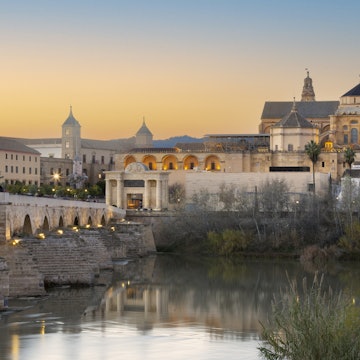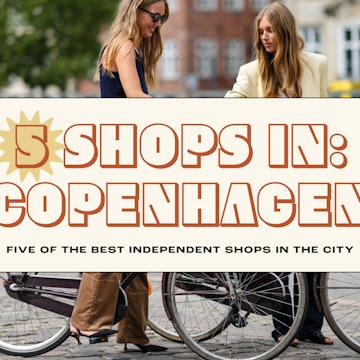
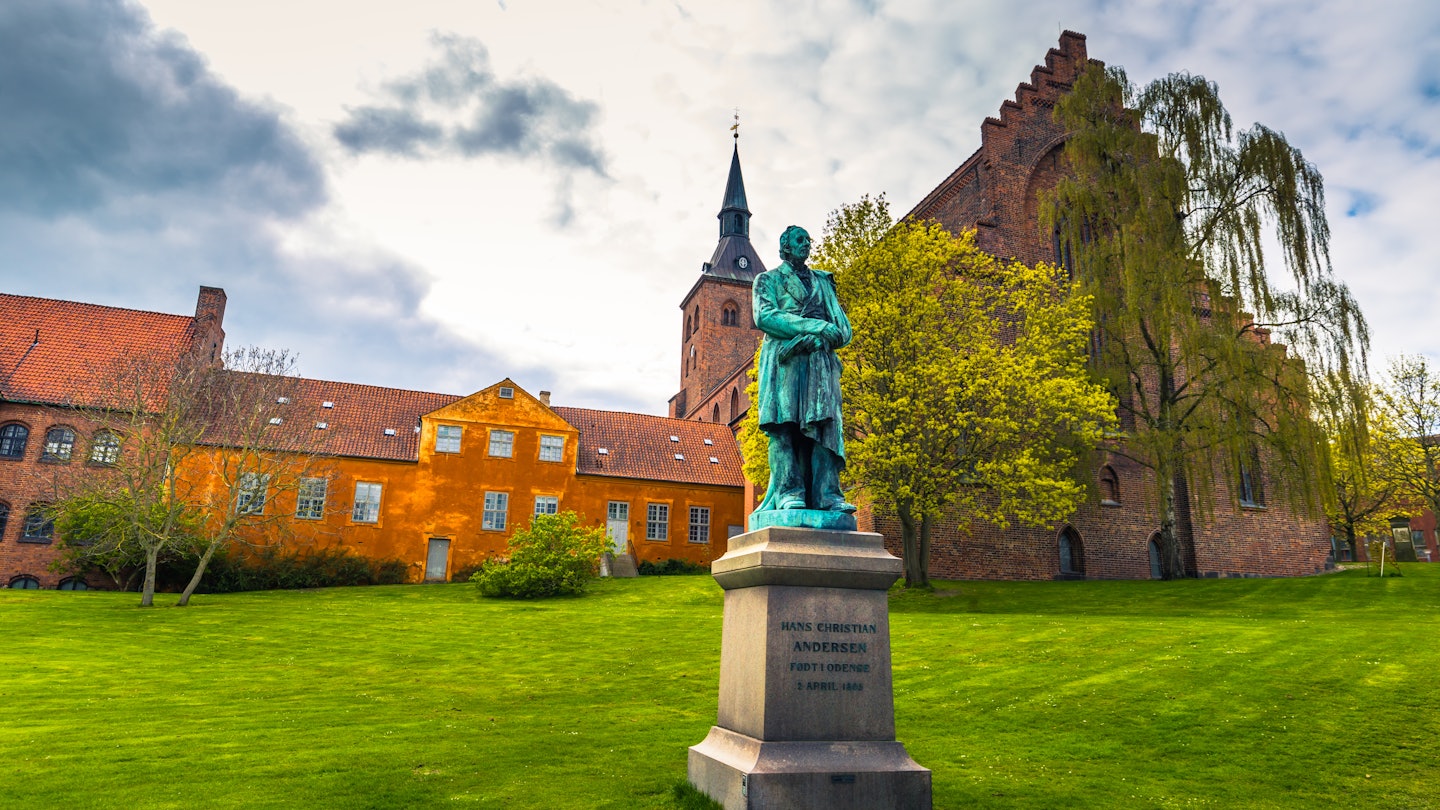
A statue of Hans Christian Andersen in a field behind the Domkirke, Odense, Denmark. RPBaiao/Shutterstock
Odense is a living homage to its favorite son, fairy-tale maestro Hans Christian Andersen. Visitors to Denmark’s third-biggest city will find tributes to the writer in everything from street art to the lights at pedestrian crossings, which reveal Andersen in silhouette when they blink.
After major construction work in recent years, this former ugly duckling of a town has reemerged almost swan-like. At its heart is the showpiece HC Andersen Hus, built in 2021 and surrounded by a spruced-up historic district that is largely traffic-free. Most of the city’s attractions are easily reached on foot or by sightseeing boats that ply the Odense River, making the city a compact delight to explore.
A visit to Odense and its island of Funen is a highlight of any trip to Denmark – and these are some of the best things to do there.

1. Set off on a immersive fairy trail at HC Andersens Hus
HC Andersens Hus is a wonderful, worthy and, well, weird tribute to one of the world’s greatest-ever storytellers. Japanese architect Kengo Kuma designed the complex of wood pavilions, spiraling gardens and subterranean gallery spaces, into which visitors embark on a high-concept, tech-forward immersion into Anderson’s life and writings. There are one or two eerie moments – so if you’re with kids aged six or under, consider skipping the main exhibition and heading straight to Ville Vau, a play town with costumes for dressing up.
The author of stories that continue to captivate readers worldwide, Andersen was a complex character worthy of his own tale. Riven by neuroses and obsessions, he carried a 2.75m-long (9ft-long) piece of rope wherever he went in case he got caught upstairs in a burning building. Terrified of being buried alive, Anderson kept a note by his bed that read, “I only appear to be dead.” Beyond writing, Andersen was remarkably accomplished at paper-cut art, delighting children and friends with his creations; many of these works are on display at HC Andersens Hus.
Be sure to book tickets, timed by 30-minute slots, in advance online.
Planning tip: In late August, Odense hosts the weeklong HC Andersen Festival, celebrating the writer with child-friendly cultural events, theater, workshops and street performances.
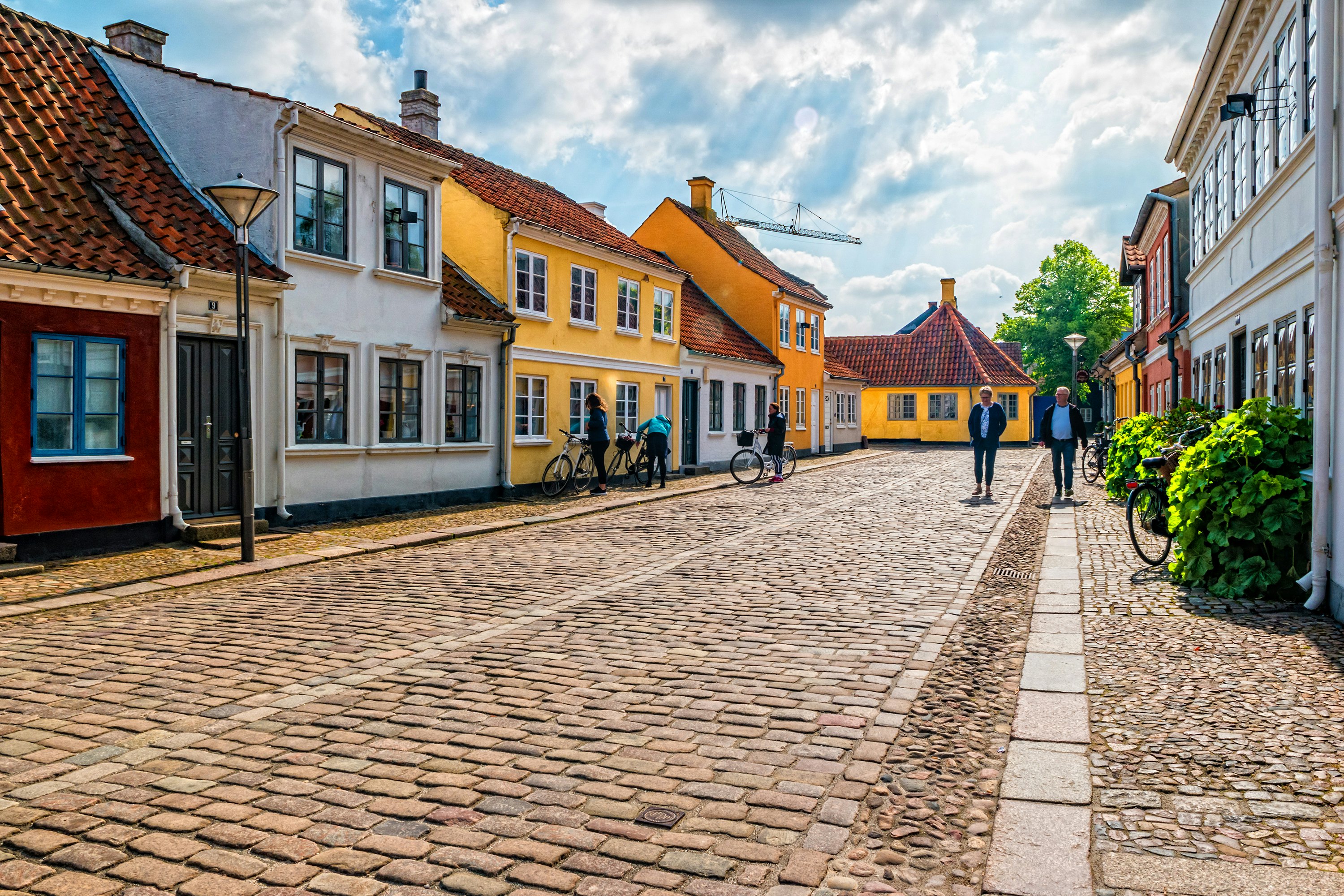
2. Explore Odense’s old town on foot
A 2.5km (1.5-mile) loop through Odense’s core provides a picturesque introduction to the city. Start with a meander through the topsy-turvy gardens surrounding HC Andersen Hus (they’re free to enter) before tracking down the nearby Andersen mural. Next, peruse the cobbled streets and historic chocolate-box houses along Bangs Boder and Ramsherred in the old quarter.
Stop for a photo at the Andersen sculptures outside the Comwell Hotel, pass the TID Museum, then hit up Vestergade, the city’s main shopping street. You’ll soon reach the Italian-esque Rådhus and Odense Domkirke, an imposing 14th-century Gothic cathedral. A couple of minutes’ walk southwest is HC Andersens Barndomshjem, the storyteller’s childhood home, where you can learn about his hardscrabble early life in his hometown.
Return to Vestergade and take Brandts Passage, where a former textile mill is now a thriving cultural hub, home to a cinema, cafe and the excellent art museum Kunst Museum Brandts. Go inside to admire works by Funen painters, plus cutting-edge photography exhibitions and shows by internationally acclaimed artists.
Detour: Before, during or after your walking tour, stop for a memorable lunch at Restaurant HOS, which serves spectacular smørrebrød and multicourse menus with wine pairings.
3. Trace the town’s turbulent history at the Domkirke and TID Museum
Millennium-old Odense was named after the Viking god Odin (its name meaning “Odin’s Shrine”) – yet it was during the early days of Christianity that the city’s fortunes took a turn. In the chilly crypt of Odense Domkirke you can peer at the 900-year-old skeleton of Denmark’s patron saint, King Knud (Canute) II, lying beside the bones of his younger brother Benedikt: both were killed in 1086 during a peasants’ revolt in the region. Knut was quickly canonized by the pope in a bid to help shore up the Catholic Church in Denmark, and his bones became the object of a popular pilgrimage, bringing considerable wealth to the town.
You can get a feel for Odense life in the Middle Ages and Renaissance – the city’s golden age – at TID Museum (TIME Museum), partly installed in a nobleman’s townhouse from 1646.
Detour: Along quaint Nedergade, the famous and delightful Kramboden, a bric-a-brac shop with countless antiques and curiosities, provides another take on the material history of the city.

4. Celebrate the joys of rail travel at Danmarks Jernbanemuseet
Not just a writer of fairy tales, poems and plays, Hans Christen Andersen was an avid traveler and travel writer who was captivated by the early days of rail travel. This makes Odense an apt location for Danmarks Jernbanemuseet, a rollicking railway museum housed in an old depot behind Odense railway station. You can look forward to clambering through more than two dozen trains, including Christian IX’s plush 1900 royal saloon car and a working replica of Denmark’s first locomotive, ODIN, from 1846.
Planning tip: Whether you’re with kids or not, the museum’s mini-train, whose tiny replicas of the museum’s rolling stock tootle around the complex several times a day, is an utter delight. Call ahead to time your museum visit to one of its several daily departures.
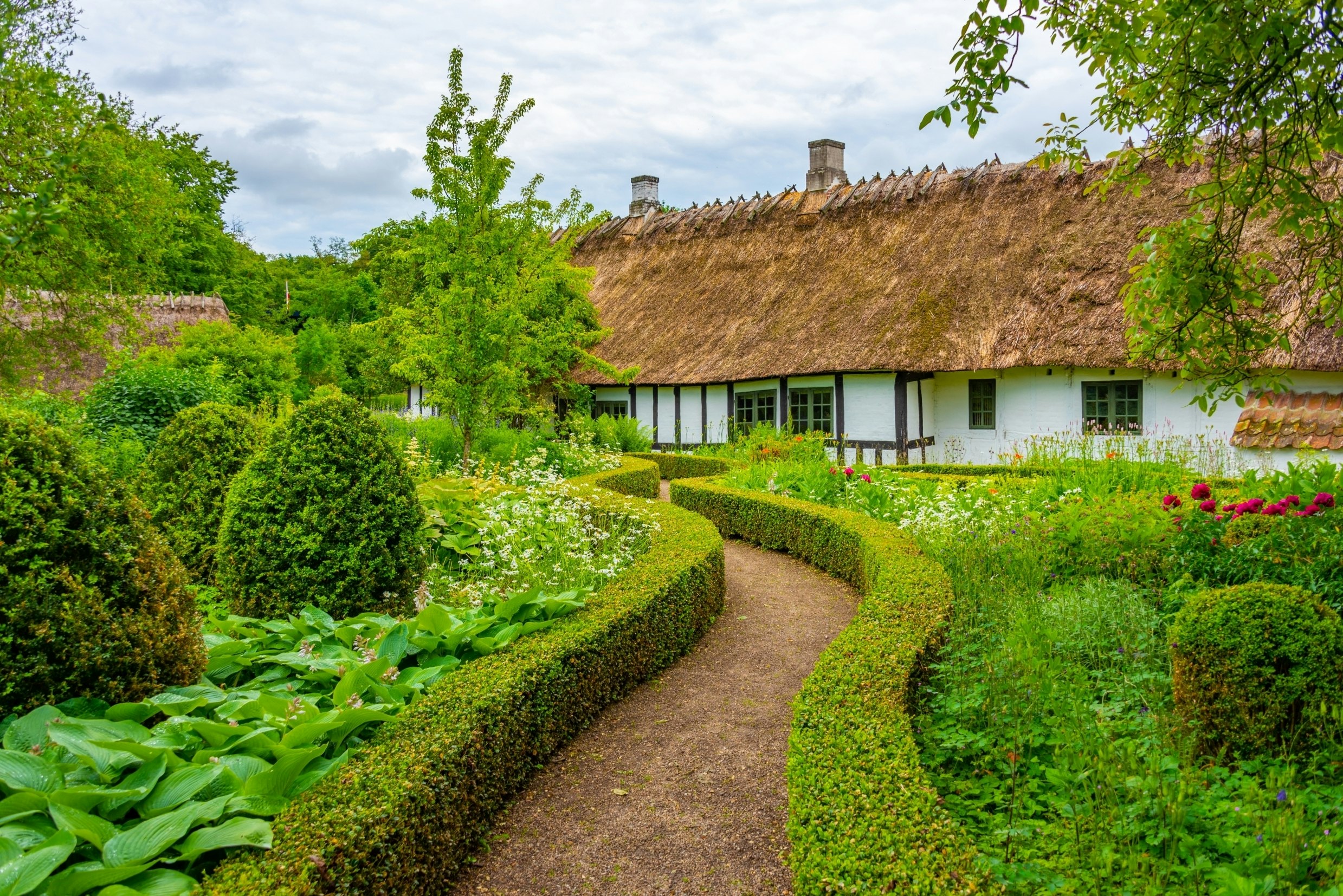
5. Go sightseeing on a riverboat
Just south of the city center, Munke Mose is a picnic-friendly park furnished with a playground, riverside footpaths and rowboats available to rent. From here, you can hop aboard an Odense Aafart riverboat for an hour-long round trip.
Taking the boat to its second and furthest stop brings you within a 15-minute walk of Den Fynske Landsby, a nostalgic open-air museum where costumed “peasants” role-play 19th-century village life amid flocks of geese and genuine period buildings transplanted from all over Funen.
Detour: The riverboat stops at Odense Zoo – and it’s well worth getting off for a bit to explore what might be the best zoo in the country.
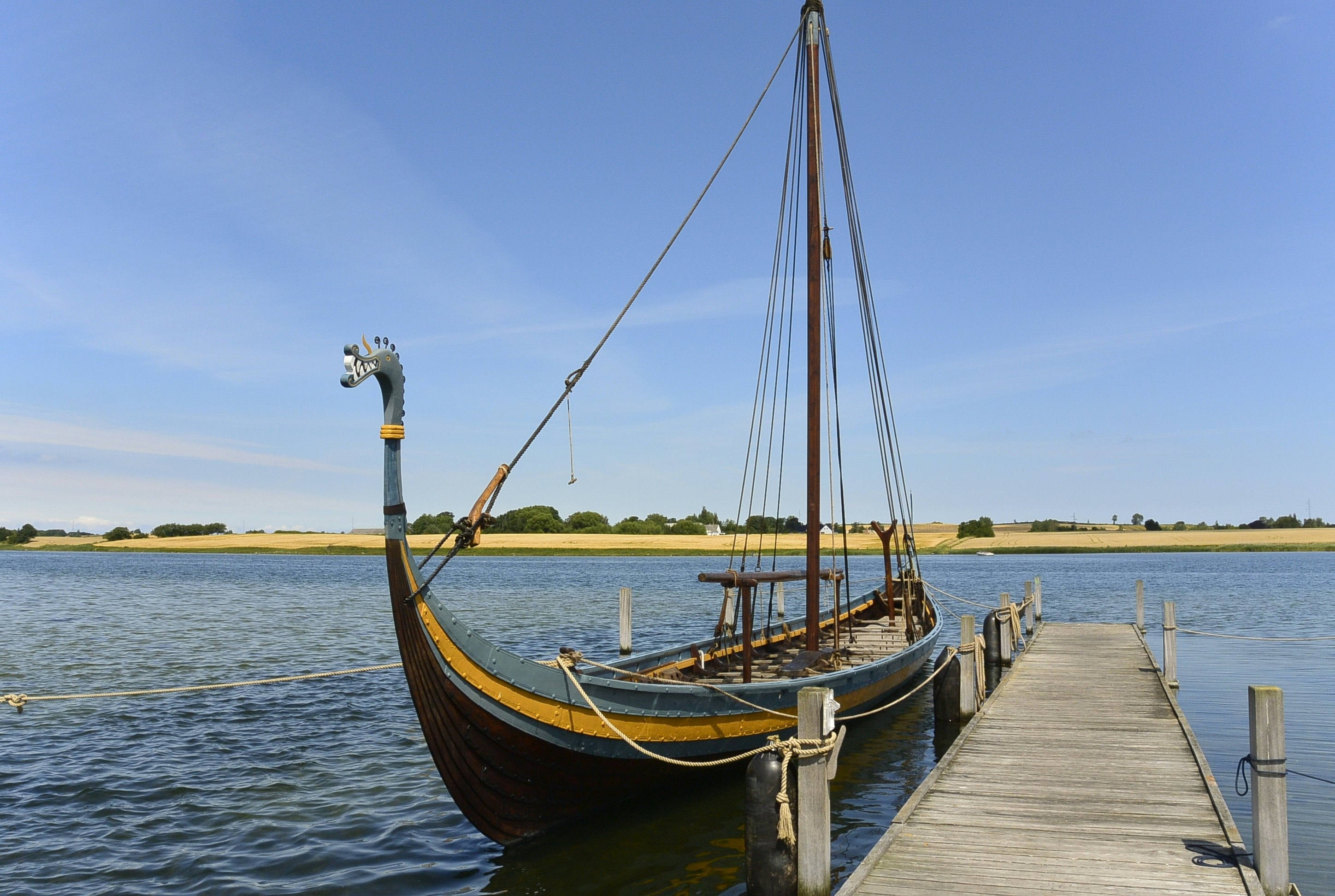
6. See art by the beach and the tomb of a Viking king in Kerteminde
Often overlooked in favor of its bigger neighbors, the underrated middle island of Funen, of which Odense is the capital, is one of Denmark’s loveliest regions. Just 25 minutes by car from the city and at the narrow entrance of a fjord, Kerteminde is a snug coastal community with a walkable core of half-timbered buildings housing inviting cafes and restaurants.
The Johannes Larsen Museet is a must for art lovers. Larsen was perhaps the most successful and prolific of the group of artists known as the Fynboerne (Funen Painters), who depicted vivid landscapes, naturalistic wildlife and scenes from everyday life at the turn of the 20th century. Larsen’s delightful home and studio are faithfully preserved; inside an impressive modern gallery is a collection of his and other local artists’ works.
Steps from the still waters of Kerteminde Fjord, a grassy mound hides within it the only known Viking-ship burial in Denmark. Around the year 925 CE, a Viking chieftain was ceremoniously laid to rest on the deck of a longship, together with weapons, tools, jewellery and sacrificial animals.
The experience begins at Vikingemuseet Ladby, which displays finds from the grave, plus a reconstruction of how the fully laden longship would have looked at the time of burial. From there, it’s a short walk across fields to the burial mound, where the ship’s ghostly remnants are revealed. Just beyond, bobbing in the fjord, is a working reconstruction of the boat, built by enthusiasts using Viking-era techniques.
Planning tip: If you’d rather lie out in the sun than sightsee, you’ll find beautiful beaches all around Kerteminde. In town, Kerteminde North Beach is a long, delightful strand just north of the marina. Further up the coast, rugged Bøgebjerg Beach is a local favorite. And at the tip of Hindsholm peninsula (and of Funen itself), Fynshoved Beach is surrounded by water on three sides, drawing comparisons to the famous cape at Skagen.
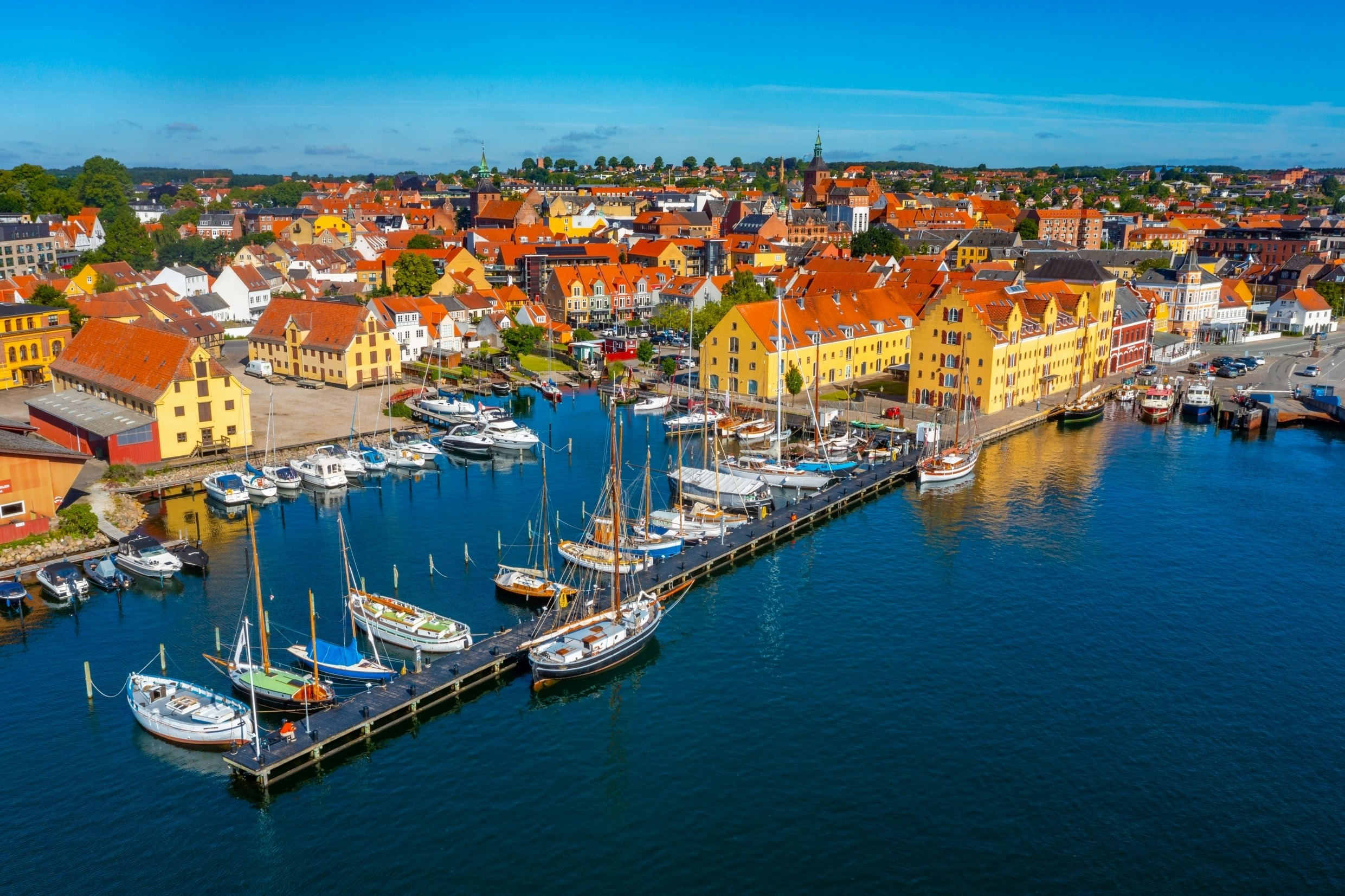
7. Immerse yourself in Denmark’s maritime culture in Svendborg
Gateway to Funen’s southern archipelago, the port town of Svendborg (45 minutes by train from Odense) is a canvas of white sails in summer, when Denmark’s yachting community spills out of marinas and into the blue waters of the Svendborgsund. The heartbeat of the harbor zone is Frederiksø, a tiny island once home to working shipyards and today to bars and cafes.
Danmarks Museum for Lystsejlads exhibits dozens of boats in a huge warehouse (opening hours are limited outside of summer). Moored alongside Frederiksø are several vintage wooden sailing ships, with more across the water at Sejlskibsbroen, a historic jetty just west of the Ærø ferry terminal.
Planning tip: Between mid-May to early September, the vintage vessel M/S Helge sets sail three or four times daily from Svendborg Harbor on a sightseeing loop around the Svendborgsund. Stops include the beach area of Christiansminde and the old maritime village of Troense.
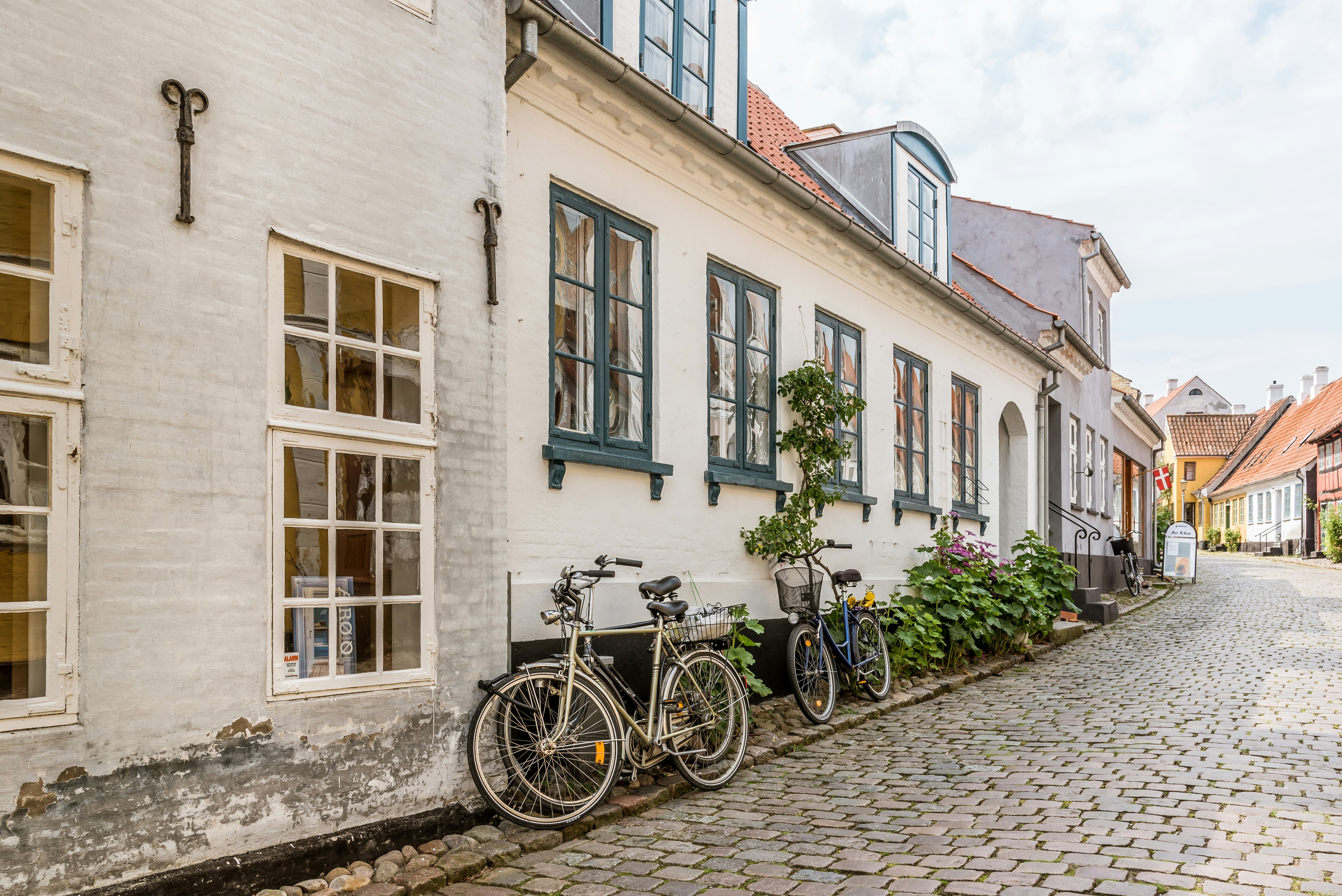
8. Explore the delightful island of Ærø by bike
The southern coast of Funen fragments into numerous pretty islands where wild horses roam and half-timbered cottages overlook beaches. The jewel of this mini-archipelago is Ærø, about two hours by train and ferry from Odense (via Svendborg). The island’s gentle terrain, quiet lanes and well-marked routes make it a dream for cyclists.
One irresistible ride connects the villages of Ærøskøbing (one of Denmark's prettiest) and Søby along a roughly 18km (11.2-mile) stretch of the Baltic Sea Cycle Route, also known as National Cycle Route N8. Follow signs marked “8” as you hug the coast, then weave inland around tiny hamlets and farmers’ fields.
Funen Cycle Route 92 follows a 10.5km-long (6.5-mile-long), car-free coastal trail between Ærøskøbing and the seafaring town of Marstal. In the latter, check out Marstal Søfartsmuseum, which is packed with model ships, paintings and maritime paraphernalia. For lovely views, pedal back via hilltop village Rise, making a pit stop at local brewery Ærø Bryggeri.
Planning tip: Bicycles can be rented from Andelen Guesthouse in Ærøskøbing, or at the gas station on Pilebækken.
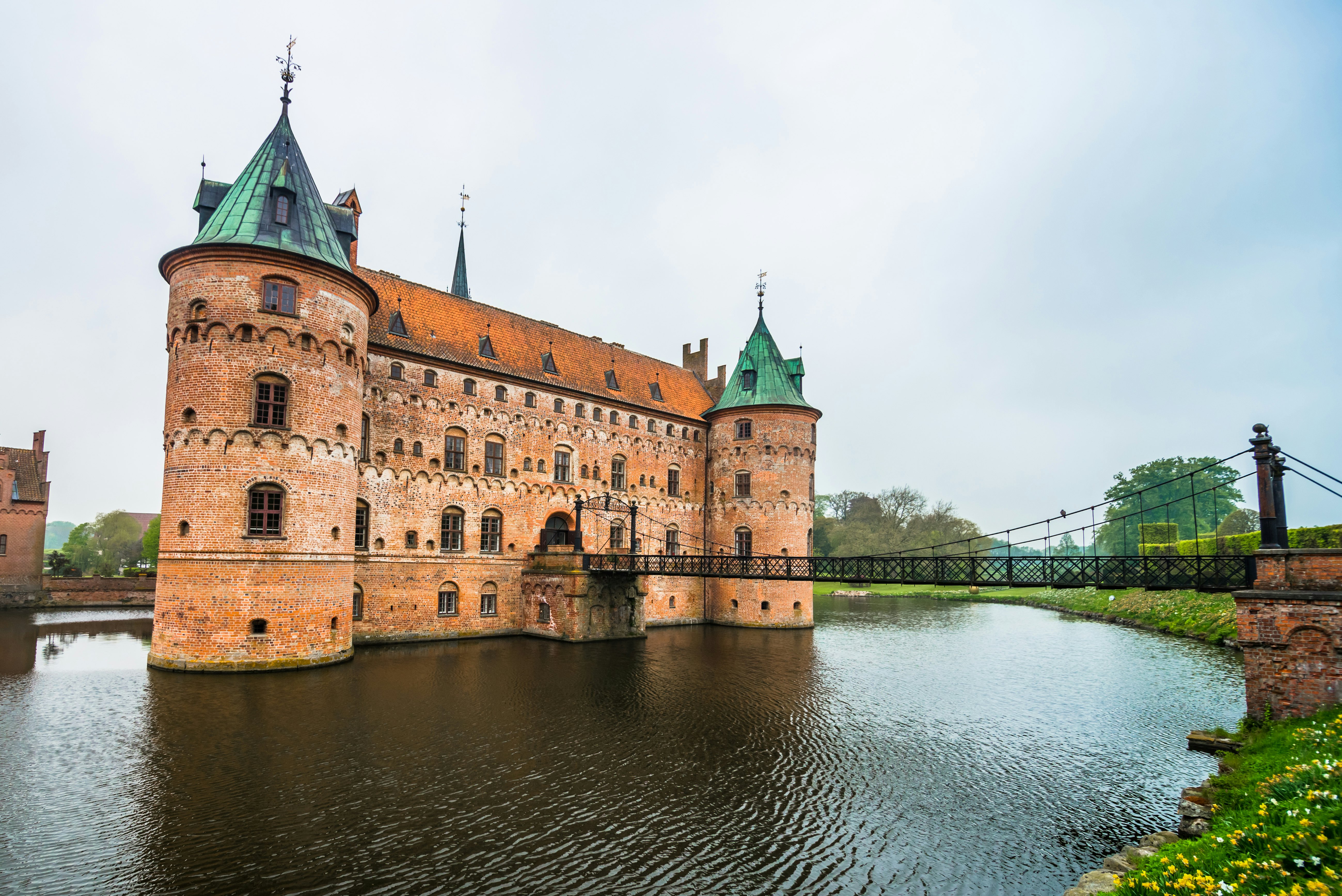
9. Make a full day of it at Egeskov Slot
Encircled by a moat and surrounded by 37 acres of landscaped gardens, 16th-century Egeskov Slot is a regal, romantic beauty. Located 32km (20 miles) from Odense (an hour by train; 30 minutes by car), the castle has extensive grounds that are home to remarkable museums, play activities and a roster of seasonal events (rock festival and Christmas markets included). You can easily spend all day here.
Built in 1554, Egeslov Slot was updated to its current Gothic-meets-Renaissance look in 1883. While part of the castle remains a residence for the family of Count Ahlefeldt-Laurvig-Bille, you can explore 13 lavishly decorated rooms filled with hunting trophies, weapons, paintings and antiques. The grounds are the highlight, however: many of the individually designed gardens are 21st-century creations, and reveal elegant topiary, rose beds, oak woodland and water features.
An extraordinary range of exhibitions fills the castle’s former barns. At the Classics Museum, motorheads will love the vintage cars (spot the DeLorean made famous in the Back to the Future movies); there are also dedicated displays of fire engines, motorcycles and even fighter jets. Europe’s first camping museum displays life-sized dioramas showcasing dreamy vintage camper vans, caravans and tents.
A smorgasbord of kid-oriented activities includes an adventure playground, a vertigo-inducing walkway in old beech trees and a pedal-powered go-kart track. Inside the castle, Titania’s Palace is a wonderfully detailed dollhouse so vast it almost fills one of the chambers.
Planning tips: Check the castle’s website for “Open by Night” events (usually Wednesdays in peak summer) when the grounds stay open until 11pm for concerts and fireworks. You can sit down for a meal at Brasserie Rigborg, or grab a bite at one of the hot-dog kiosks on site. Picnics are permitted if you prefer to self-cater.
This article was adapted from Lonely Planet’s Scandinavia guidebook, published in July 2025.












